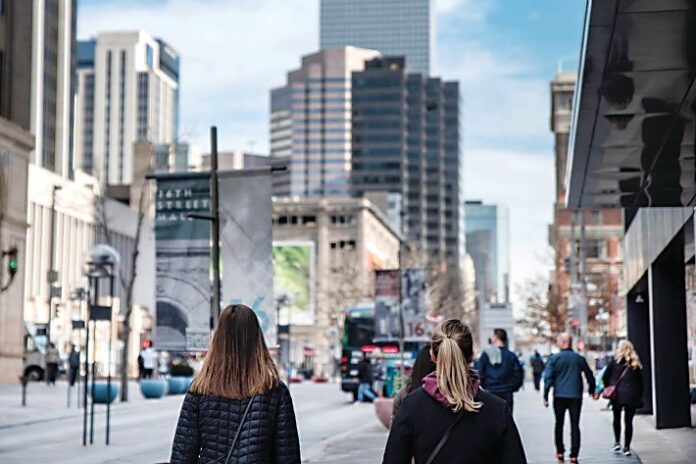The urban workhorse of Colorado’s tourism industry is finally recovering from COVID.
Denver and its Front Range neighbors have endured long-haul symptoms from the pandemic, as convention and city tourism struggled to recover from shutdowns and the collapse of both leisure and business tourism.
While other more rural communities rebounded quickly — perhaps too quickly as crowds overwhelmed mountain towns enduring a labor shortage — Colorado’s urban tourism industry in Denver has not yet reached pre-pandemic levels of traffic.
But it is getting there. The latest study by the city of Denver shows the metro area’s visitor levels pacing right behind the record-setting performance of 2019 and regaining much of the loss the city experienced during the height of the pandemic.
Travelers made 31.7 million trips to the city last year, only slightly fewer the 31.9 million trips made pre-pandemic and and a 14.5% increase from 2020, according to the latest report by travel research firm Longwoods International, which has compiled annual tallies of Colorado tourism since the 1990s.
Travel spending brought in $6.6 billion for Denver in 2021 — a 26% jump from the year before, new data shows. Leisure travel carried Denver’s rebound with 14.8 million trips, compared with 11.6 million in 2020.
“Thankfully, Denver is a very resilient economy and we have worked closely together to get ourselves out of this and on to recovery,” said Richard Scharf, president and CEO of Visit Denver. “So I think the worst part is behind us.”
More than 15 million day trips were made in 2021, with people traveling at least 50 miles from home to visit top attractions, including Red Rocks Park and Amphitheatre, Denver Art Museum, Denver Zoo, and the Colorado Rockies. The 16th Street Mall and Cherry Creek Mall were among the top shopping destinations.
But the recovery is uneven. After business travel to Colorado collapsed in 2020, dropping to 1.8 million trips from 2.4 million in 2019, the number of people traveling to Denver for work barely budged last year.
“We know that the business traveler and the convention business is going to be a slow ramp up. We’ve seen that and we know that’s going to be true for a little while,” Scharf said.
Since Outdoor Retailer, a twice-a-year trade show, decamped Denver for its former home of Salt Lake City, Scharf said Denver has been approached by “innovative outdoor shows” that “are trying to take advantage of the new frontier.” He declined to give more details.
The national outdoor trade show had a $45 million annual impact for Denver.
“We hate to have them leave, but we run a pretty good occupancy in the summers,” Scharf said. “We’ve got great demand.”
As Colorado began to welcome visitors back in 2020, the state’s tourism office revived marketing campaigns, using federal stimulus dollars, to buoy its tourism industry. Marketing campaigns focused on city tourism and international visitors, both of which have been slow to rebound from the pandemic and shutdowns.
Mountain towns’ rebound from the pandemic tell a different story. As people sought wide open space amid the pandemic, managers in towns such as Crested Butte, Telluride and Breckenridge hastened their transition from destination marketing to management amid low staffing levels and affordable housing for its workers.
Colorado’s ski areas also saw record numbers of visitors in the 2021-22 ski season with more than 14 million visitors.
In Colorado Springs, visitor numbers have surpassed pre-pandemic levels. In 2021, the city attracted 23.7 million visitors, which was a nearly 12% increase from the previous year and more than a 5% jump from 2019, data from Visit Colorado Springs show.
Amy Long, chief innovation officer for Visit Colorado Springs, attributed the surge of visitors to the city’s many trails and open spaces, as well as the Pikes Peak Summit Visitor Center and the cog railway, both which opened in June 2021.
The city targeted its marketing to Colorado residents, those living in surrounding states and Texas, Long said.
Will the rising prices at the gas pumps affect travel to Colorado in the future? Possibly, but for now, people are still hitting the roads, said Amir Eylon, president and CEO of Longwoods International.
“People are going. They’re just finding ways to reallocate their travel budget,” Eylon said.
According to AAA’s national travel forecast, 42 million people will likely road trip over the July 4 weekend — in what would be a record for car travelers over the holiday — amid historically high gas prices. Denver is among AAA’s top 10 travel destinations for the weekend.
“This next year is going to be a very good year for regional drive travel,” Eylon said.
International visitors are still slowly trickling into Denver, and it’s unclear when business travel will ramp back up again.
“So we still have a long road ahead of us for recovery,” Eylon said. “But clearly Denver’s accelerating nicely down there at this point.”
This story is from The Colorado Sun, a journalist-owned news outlet based in Denver and covering the state. For more, and to support The Colorado Sun, visit coloradosun.com. The Colorado Sun is a partner in the Colorado News Conservancy, owner of Colorado Community Media.










